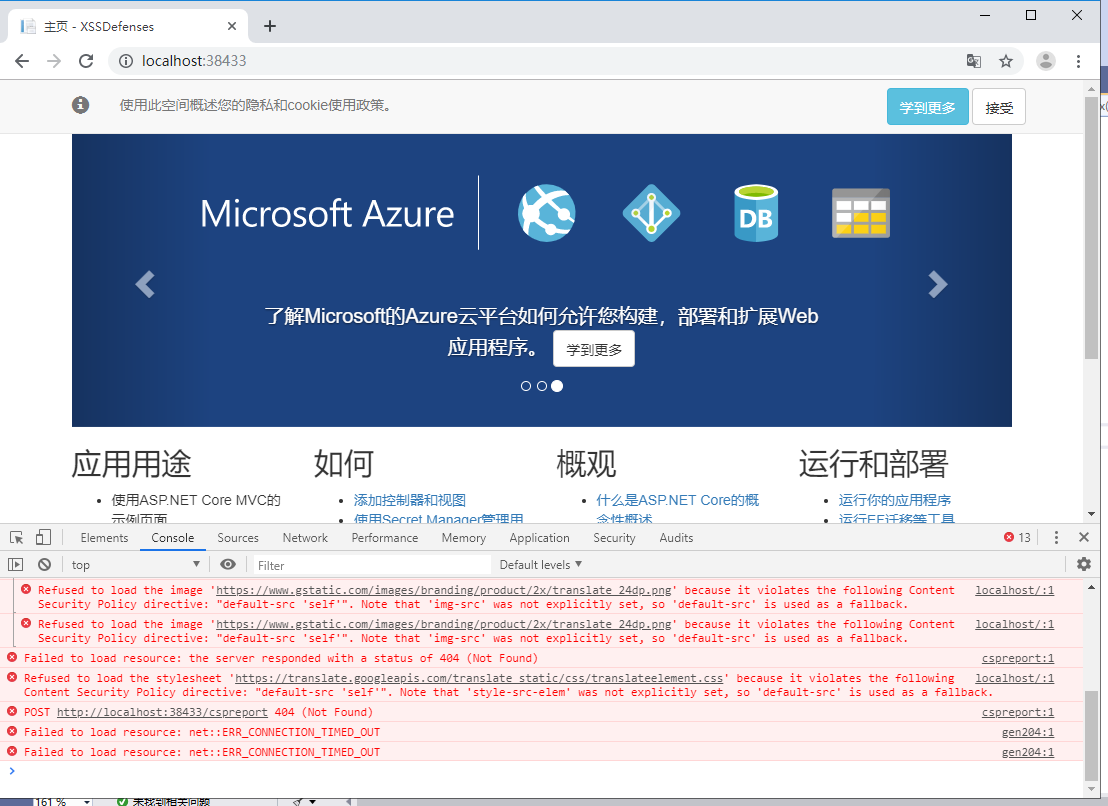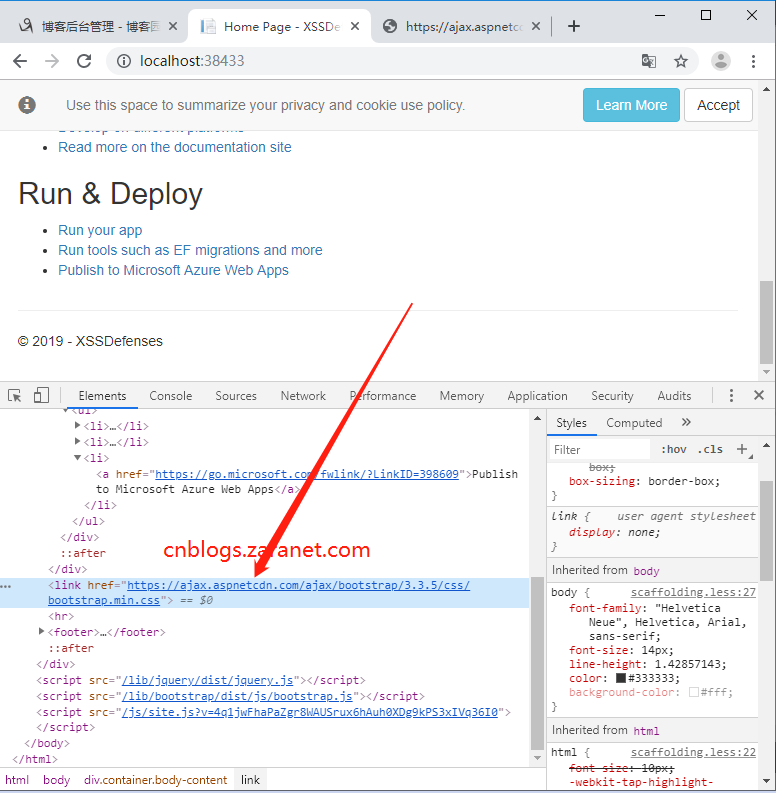ASP.NET Core中使用Csp標頭對抗Xss攻擊
- 2019 年 10 月 3 日
- 筆記
內容安全策略(CSP)是一個增加的安全層,可幫助檢測和緩解某些類型的攻擊,包括跨站點腳本(XSS)和數據注入攻擊。這些攻擊用於從數據竊取到站點破壞或惡意軟體分發的所有內容(深入CSP)
簡而言之,CSP是網頁控制允許載入哪些資源的一種方式。例如,頁面可以顯式聲明允許從中載入JavaScript,CSS和影像資源。這有助於防止跨站點腳本(XSS)攻擊等問題。
它也可用於限制協議,例如限制通過HTTPS載入的內容。CSP通過 Content-Security-Policy HTTP響應中的標頭實現。
啟用CSP,您需要配置Web伺服器以返回Content-Security-PolicyHTTP標頭。那麼在這篇文章中,我們將要嘗試將CSP添加到ASP.NET Core應用程式中。
app.Use(async (ctx, next) => { ctx.Response.Headers.Add("Content-Security-Policy", "default-src 'self'; report-uri /cspreport"); await next(); });
在Home/Index中引入cdn文件,然後我們啟動項目,看看會發生什麼!

運行並觀察錯誤。載入頁面時,瀏覽器拒絕從遠程源載入。

所以我們可以組織CSP來控制我們的白名單,在配置當中需要填寫來源以及內容,以下是常用限制的選項。
來源:
*: 允許任何網址。 ‘self’: 允許所提供頁面的來源。請注意,單引號是必需的。 ‘none’: 不允許任何來源。請注意,單引號是必需的。 Host: 允許指定的互聯網主機(按名稱或IP地址)。通配符(星號字元)可用於包括所有子域,例如http://*.foo.com ‘unsafe-line’: 允許內聯腳本 ‘nonce-[base64-value]’: 允許具有特定nonce的內聯腳本(使用一次的數字)。對於每個HTTP請求/響應,應該對nonce進行加密和唯一。
指令:
script-src:定義有效的JavaScript源 style-src:定義樣式表的有效來源 img-src:定義有效的影像源 connect-src:定義可以進行AJAX調用的有效源 font-src:定義有效的字體來源 object-src:定義<object>,<embed>和<applet>元素的有效源 media-src:定義有效的音頻和影片源 form-action:定義可用作HTML <form>操作的有效源。 default-src:指定載入內容的默認策略
我們可以在可重用的中間件中封裝構建和添加CSP頭。以下是一個讓您入門的示例。你可以根據需要擴展它。首先,創建一個用於保存源的類。
public class CspOptions { public List<string> Defaults { get; set; } = new List<string>(); public List<string> Scripts { get; set; } = new List<string>(); public List<string> Styles { get; set; } = new List<string>(); public List<string> Images { get; set; } = new List<string>(); public List<string> Fonts { get; set; } = new List<string>(); public List<string> Media { get; set; } = new List<string>(); }
開發一個中間件一定是需要一個構造器的,這將用於.net core 的注入到運行環境中。
public sealed class CspOptionsBuilder { private readonly CspOptions options = new CspOptions(); internal CspOptionsBuilder() { } public CspDirectiveBuilder Defaults { get; set; } = new CspDirectiveBuilder(); public CspDirectiveBuilder Scripts { get; set; } = new CspDirectiveBuilder(); public CspDirectiveBuilder Styles { get; set; } = new CspDirectiveBuilder(); public CspDirectiveBuilder Images { get; set; } = new CspDirectiveBuilder(); public CspDirectiveBuilder Fonts { get; set; } = new CspDirectiveBuilder(); public CspDirectiveBuilder Media { get; set; } = new CspDirectiveBuilder(); internal CspOptions Build() { this.options.Defaults = this.Defaults.Sources; this.options.Scripts = this.Scripts.Sources; this.options.Styles = this.Styles.Sources; this.options.Images = this.Images.Sources; this.options.Fonts = this.Fonts.Sources; this.options.Media = this.Media.Sources; return this.options; } } public sealed class CspDirectiveBuilder { internal CspDirectiveBuilder() { } internal List<string> Sources { get; set; } = new List<string>(); public CspDirectiveBuilder AllowSelf() => Allow("'self'"); public CspDirectiveBuilder AllowNone() => Allow("none"); public CspDirectiveBuilder AllowAny() => Allow("*"); public CspDirectiveBuilder Allow(string source) { this.Sources.Add(source); return this; } }
好了,我們創建一個中間件。
namespace XSSDefenses.XSSDefenses.MiddlerWare { public sealed class CspOptionMiddlerWare { private const string HEADER = "Content-Security-Policy"; private readonly RequestDelegate next; private readonly CspOptions options; public CspOptionMiddlerWare( RequestDelegate next, CspOptions options) { this.next = next; this.options = options; } public async Task Invoke(HttpContext context) { context.Response.Headers.Add(HEADER, GetHeaderValue()); await this.next(context); } private string GetHeaderValue() { var value = ""; value += GetDirective("default-src", this.options.Defaults); value += GetDirective("script-src", this.options.Scripts); value += GetDirective("style-src", this.options.Styles); value += GetDirective("img-src", this.options.Images); value += GetDirective("font-src", this.options.Fonts); value += GetDirective("media-src", this.options.Media); return value; } private string GetDirective(string directive, List<string> sources) => sources.Count > 0 ? $"{directive} {string.Join(" ", sources)}; " : ""; } }
以及設置它的擴展方法。
namespace XSSDefenses.XSSDefenses.Extensions { public static class CspMiddlewareExtensions { public static IApplicationBuilder UseCsp( this IApplicationBuilder app, Action<CspOptionsBuilder> builder) { var newBuilder = new CspOptionsBuilder(); builder(newBuilder); var options = newBuilder.Build(); return app.UseMiddleware<CspOptionMiddlerWare>(options); } } }
我們現在可以在Startup類中配置中間件。
app.UseCsp(builder => { builder.Styles.AllowSelf() .Allow(@"https://ajax.aspnetcdn.com/"); });
啟動發現,觀察網路資源。瀏覽器已經允許本地和遠程資源。

Github地址 https://github.com/zaranetCore/-.NET-Core-And-XSSDefensesSolucation
